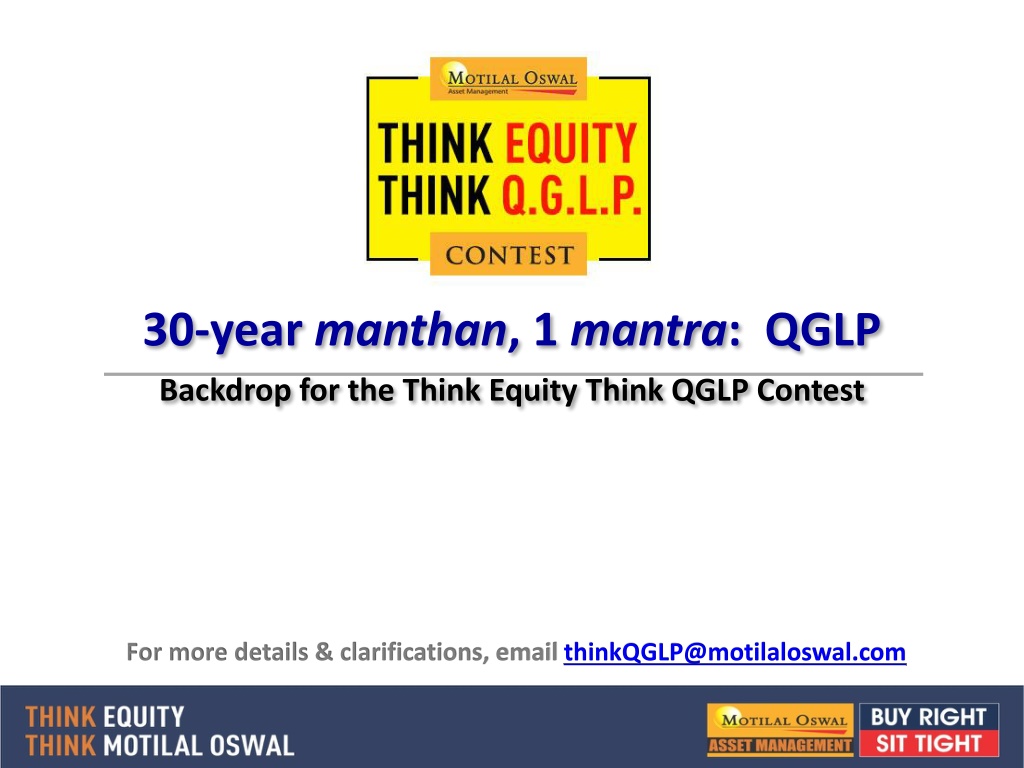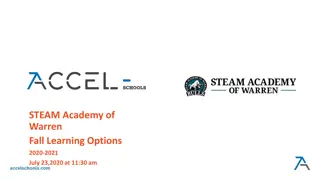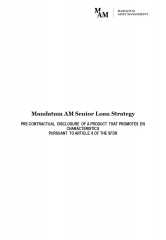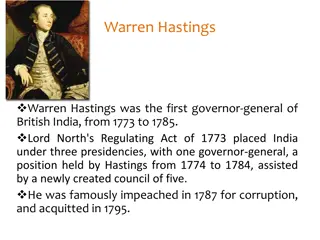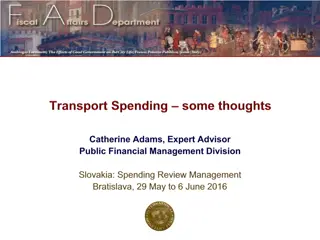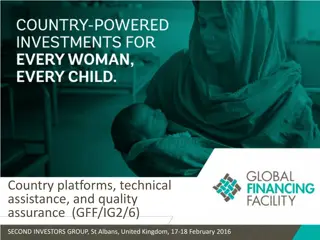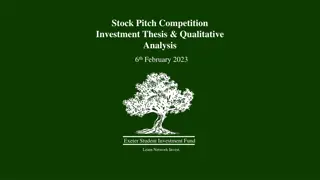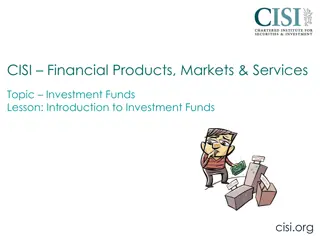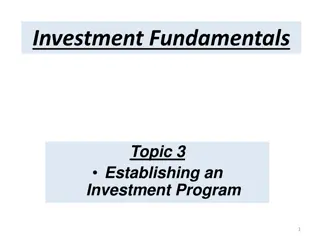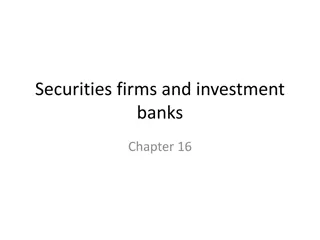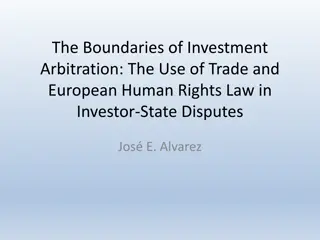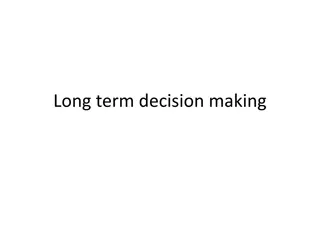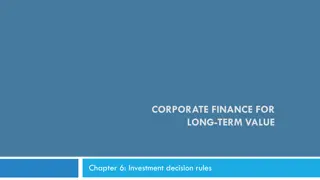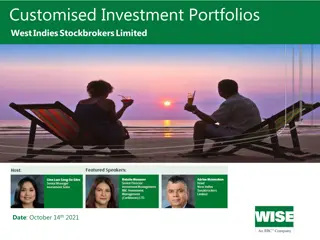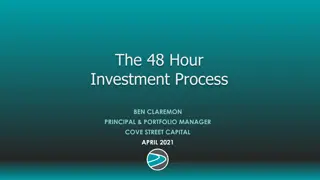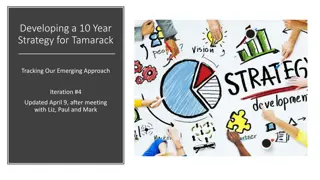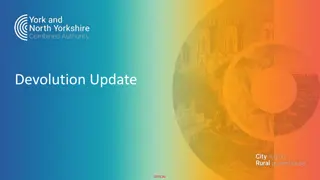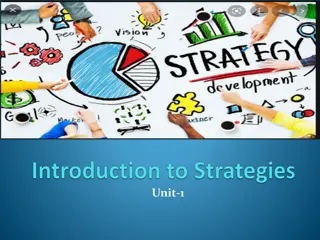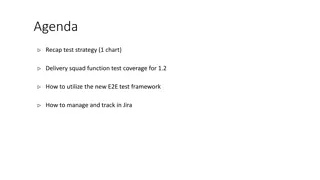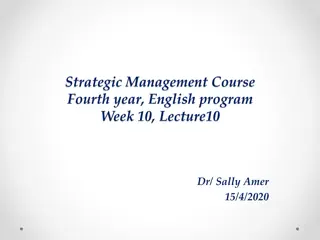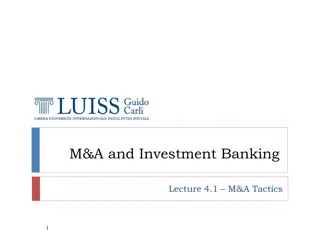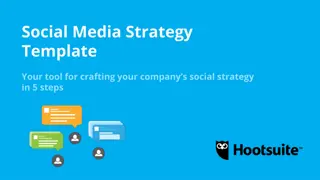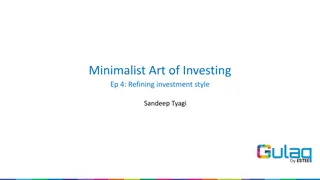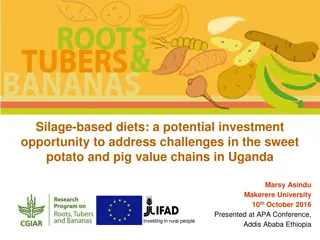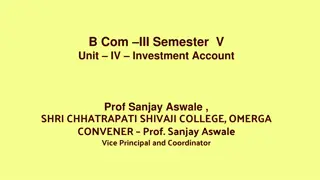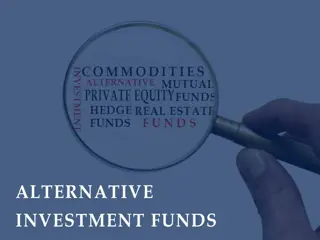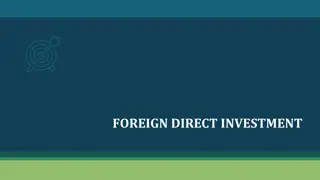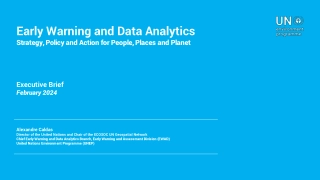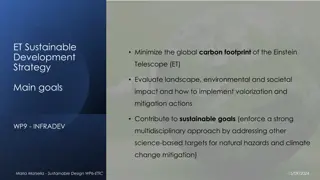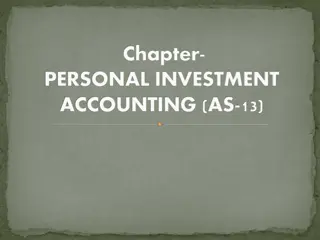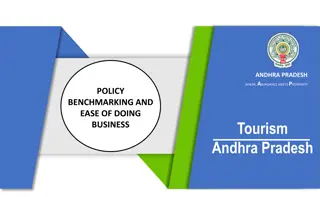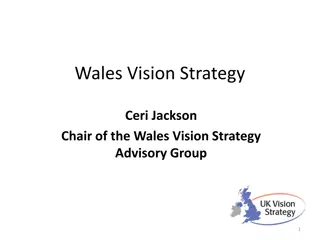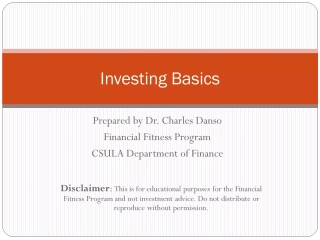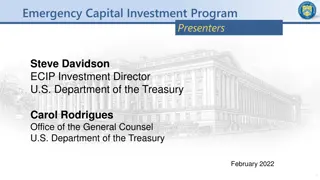Understanding QGLP Investment Strategy and Warren Buffett's Approach
The QGLP investment strategy focuses on Quality, Growth, Longevity, and reasonable Price when selecting potential investments. This strategy emphasizes the importance of understanding the business, its growth prospects, management quality, and valuation. Warren Buffett's investing process aligns with QGLP by emphasizing investing in businesses with favorable long-term economics, trustworthy management, and a sensible price tag. Both approaches stress the importance of sustainable competitive advantage, competent management, and financial strength, combined with a margin of safety for investors.
Download Presentation

Please find below an Image/Link to download the presentation.
The content on the website is provided AS IS for your information and personal use only. It may not be sold, licensed, or shared on other websites without obtaining consent from the author. Download presentation by click this link. If you encounter any issues during the download, it is possible that the publisher has removed the file from their server.
E N D
Presentation Transcript
30-year manthan, 1 mantra: QGLP Backdrop for the Think Equity Think QGLP Contest For more details & clarifications, email thinkQGLP@motilaloswal.com
The manthan Knowledge churn Wide-range of readings on business & investing
The manthan Knowledge churn Rich learnings from 21 years of Wealth Creation Studies
Warren Buffetts investing process a) A business we understand; b) Favorable long-term economics; c) Able and trustworthy management; and d) A sensible price-tag. 2007 Annual Letter
QGLP in a nutshell QGLP Quality, Growth, Longevity, reasonable Price Growth in earnings Volume growth Price growth Mix change Operating leverage Financial leverage Quality of business x Quality of management Stable business, preferably consumer facing Huge business opportunity Sustainable competitive advantage Competent management team Healthy financials & ratios QGLP Price Longevity of both Q & G Long-term relevance of business Extending competitive advantage period Initiatives to sustain growth for 10-15 years Reasonable valuation, relative to growth prospects High margin of safety Prefer stocks with PEG of around 1x
Q Quality High quality business x High quality management Quality of management Quality of business Unquestionable integrity Impeccable corporate governance Concern for all stakeholders Preferably paying full tax and a well-articulated dividend policy Large profit pool Size of opportunity (eg IT, Pharma, Financials) Competitive landscape Monopoly (Bosch), Oligopoly (OMCs) Dominant market share (Asian Paints, United Spirits) Demonstrable competence Excellence in strategy & execution Sustaining competitive advantage Growth mindset Long-range profit outlook Efficient capital allocation Niche / Strategic opportunity (Eicher, Page Industries) Favourable demand-supply
G Growth in earnings Understanding short-term Growth is a science but Understanding long-term Growth is an art A lollapalooza of C, V, P, M Cost, Volume, Price, Mix (lollapalooza is a big effect from large combinations of factors) Growth = Earnings growth x Valuation growth
G Growth in earnings High earnings growth situations Value Migration flow of value (profit & market cap) from outmoded businesses to superior businesses (e.g. wired telephony to wireless, public sector banks to private banks, etc) Sustained industry tailwind Small base with large opportunity New large investment getting commissioned Inorganic growth through M&A Consolidation of competition Operating & Financial leverage Turnaround from loss to profit
L Longevity Longevity of both Quality and Growth No breakdown of the business model for the foreseeable future Growth sustained over the long-term huge opportunity size periodic new product launches / capacity expansion non value-dilutive inorganic growth
P Price Reasonable Price i.e. well below intrinsic value, leaving good Margin of Safety Several valuation approaches possible Some proprietary formulas 1. Payback ratio Less than 1x is almost a sureshot formula for multi-bagger Payback ratio = Next 5 years PAT 2. PEG (PE to Future growth) Less than 1x improves chances of huge wealth creation Market Cap
QGLP Case Studies 1. Bajaj Finance 2. HPCL 3. Eicher Motors 4. Page Industries 5. Bosch 6. Voltas 7. Max Financial Services 8. Kotak Mahindra Bank 9. City Union Bank 10. Cummins
QGLP Case 1: Bajaj Finance Q Quality Quality of Business Bajaj Finance has a clear moat in the consumer durable financing business In an opex-heavy business, it has effectively used technology to lower operational costs It has developed strong cross-selling capabilities enabling asset-sweating. It aims to achieve a cross-sell ratio of 5-6 products per customer (global benchmark) Its strong relationships with dealers is key to attract high volumes and acquire customers. QGLP Quality of Management Strong pedigree promoted by Bajaj Group with 57% stake held by Bajaj Finserv Competence: It has delivered 59% PAT CAGR over last five years; internally, the management works and thinks like a bank especially, when it comes to raising funds at cheap cost. Lower cost of funds is the biggest source of moat in financing business Integrity: Flawless track record of corporate governance; steady payout of 12-13% Growth mindset: Management has steadily found new lending segments in a commoditized business like lending e.g. lifecare financing
QGLP Case 1: Bajaj Finance G Growth Bajaj Finance s 4-year AUM CAGR is a high 44%; PAT CAGR 38% This implies it is not merely growing, but delivering profitable growth The key positive of this strong growth is that it has been able to raise capital at 4- 5x book value Going forward, as India s penetration of white and brown goods rises, Bajaj Finance is best placed to capitalize on this opportunity Bajaj Finance will also continue to expand its presence geographically into Tier-II & III cities It has delivered the above growth in the worst of credit cycles QGLP
QGLP Case 1: Bajaj Finance L Longevity India s credit to GDP is relatively low at 60-65%, implying long-term sustained growth opportunity Given Bajaj Finance s strong dealer presence and high-end systems and processes, it should sustain higher-than-sector growth for a long time Expect Bajaj Finance to evolve into a full-fledged commercial bank QGLP P Price TTM P/E of 32x and Price/Book of 5.2x are reasonable, considering sustainable RoE of 20% and PAT CAGR of 30% Expect stock return of 25-30% in line with earnings growth
QGLP Case 2: HPCL Q Quality Quality of Business India s 3rd largest oil refining & marketing company, market share of ~25% Key beneficiary of oil sector deregulation including free pricing of auto fuels Favorable competitive landscape only 3 major state-owned players, private sector slow in ramping up fuel pumps Post-deregulation, RoE (consolidated) bounces back to 30% levels in FY16 QGLP Quality of Management Competence: Over four-decade track record of focused business. Integrity: Track record of sound corporate governance; dividend payout of 25%+ Growth mindset: Investment in continuous modernization and expansion 49% stake in a 9 million ton refinery in Bhatinda, Punjab
QGLP Case 2: HPCL G Growth 7-8% sustained volume growth in auto fuels Significant headroom for marketing margin to gradually expand from current levels of Rs 1.5 per litre (USc 2.2) to global levels of USc 5 per litre The company is increasing its focus on non auto fuel products currently less than 10% of EBITDA vis- -vis global average of 40% Post-deregulation, healthy cash flows to help redeem debt, leading to some financial leverage QGLP
QGLP Case 2: HPCL L Longevity Auto fuels to remain relevant in India for the foreseeable future Company regularly investing for growth, both organic and inorganic, across the oil & gas value chain QGLP P Price Valuation attractive at single-digit P/Es Expect stock return of at least 25% on the back of earnings growth and valuation re-rating
QGLP Case 3: Eicher Motors Q Quality Quality of Business 95% share in 250cc+ motorcycles through the Royal Enfield brand India s third largest commercial vehicles player in JV with Volvo; Eicher has 54.4% stake Premiumization in 2-wheelers; also, growing culture of leisure biking in India Asset light and high cash generating business with zero capital employed; RoE is 50%+ The only 2-wheeler company with significant pricing power due to lack of competition QGLP Quality of Management Competence: Highly competent management with strong focus on costs and known for their frugal manufacturing style. Integrity: JV with Volvo is empirical evidence of integrity and credibility Growth mindset: Global ambitions in 2-wheelers; The CEO has shifted to London to oversee the international foray Aggressive entry into CVs and CV engines is also testimony to growth mindset
QGLP Case 3: Eicher Motors G Growth Excess demand situation in motorcycles over last 5 years despite a 9x increase in production to 0.45mn Motorcycles waiting period at 3-4 months lends growth visibility Expect volumes to double over 3 years, in line with production The Indian CV industry can grow at 10% annually for the next 10 years with 20% CAGR during an upcycle VECV has only 3.7% share in HD trucks that forms half the industry. Market share gains can drive 13% volume CAGR over 10 years Exports is a huge opportunity, in motorcycles, CVs and CV engines Over next 3 years, expect revenue to double and PAT to grow 2.7x QGLP
QGLP Case 3: Eicher Motors L Longevity Leisure biking appears to be a mega trend in India; Eicher s motorcycles may even start getting used for commuter biking Low market share in CVs lends longevity to growth prospects Volvo s search for low cost manufacturing hubs in Asia could further shift production of auto parts and engines to VECV. QGLP P Price Prima facie, valuation appears rich with P/E of 54x TTM & 25x CY17 However, major de-rating unlikely given RoE of 40%+ and doubling of earnings in 3 years Expect stock return of 22-25% in line with earnings growth
QGLP Case 4: Page Industries Q Quality Quality of Business Play on branded, premium innerwear in India, a fast-growing niche Page is exclusive franchisee of Jockey International in India, Dubai, Sri Lanka, Nepal and Bangladesh till 2030 High entry barriers given strong brand recall, widespread distribution, and integrated manufacturing QGLP Quality of Management Competence: Page awarded by Jockey International Inc. for 20 years of service and dedication to the Jockey Brand between years 1995 and 2015; RoE consistently at a high 50-60% Integrity: Flawless track record of corporate governance; high payout of ~50% Growth mindset: Consistent entry into new categories (women s innerwear, leisure wear, kids wear and swim wear) and new SKUs in existing categories
QGLP Case 4: Page Industries G Growth Continuous value migration in innerwear at two levels, from (1) unbranded to branded, (2) branded to premium branded The mid- and premium innerwear industry in India is growing at about 13% p.a.; expect Page to grow at least 20% Page is growing at three levels (1) Unabated launch of new SKUs in existing categories (2) Entering new categories; and (3) Steadily increasing market share across categories Page is continuously investing in IT to lower working capital, and interest costs Last 10-year Sales CAGR at 35%, PAT CAGR at 47%; expect future rates to be marginally lower given high base QGLP
QGLP Case 4: Page Industries L Longevity Innerwear is a relevant product for nearly eternity Longevity of premium innerwear is high given low penetration QGLP Management has taken up several initiatives to sustain both topline and bottlom line growth for a fairly long period P Price At current price levels, Page s valuation seems rich with TTM P/E at 70x Valuations have run-up sharply; we continue to hold given huge opportunity, healthy profit growth, high RoE and healthy payouts
QGLP Case 5: Bosch Q Quality Quality of Business Dominant market share in diesel fuel injection systems with monopoly in certain auto sub segments High entry barriers: (a) technology leadership supported by a strong parent; (b) stickiness with customers; (c) cost leadership due to scale and localization Good cash generation, ROEs of 15%+ despite underlying cyclicality QGLP Quality of Management Competence: Ability to maintain dominant market share over a long period and strong focus on productivity enhancement Integrity: Strong corporate parent; track record of ~20% dividend payout Growth mindset: Ahead of the curve in developing low cost localized products required due to emission norm changes, which helps it capture a large chunk of a new market
QGLP Case 5: Bosch G Growth The underlying sub segments like tractors, CV, PV, 3W & 2W have long term growth potential of 8-10% annually and 12-15% in an economic upswing. Emission norm related changes due to BS4 & BS6 will result in requirement of new products almost 3-4x the cost of existing ones over the next 5 years. The corresponding new market creation is almost 3x the revenues of the company. Strong pricing power due to monopoly position provides operating leverage. Option value if India emerges as a manufacturing hub for global auto companies over next 10 years. QGLP
QGLP Case 5: Bosch L Longevity Fuel injection systems in automobiles will exist for a long time Opportunities like Euro VI emission norms will sustain profitable growth over the medium and long term QGLP P Price Prima facie, valuation appears rich with P/E of 57x TTM & 35x FY18 Given strong, longevated growth prospects over next 5 years led by regulation, expect valuations to remain elevated while earnings growth will drive stock returns.
QGLP Case 6: Voltas Q Quality Quality of Business Market leader in room air conditioning in India with a 20% share. Well-entrenched distribution network (over 11,000 touch-points/7000 dealers), a key entry barrier in the industry. Core RoCE of 43% (FY16) which is reflective of the strength of its business model of largely outsourced manufacturing (runs only an assembly operation) and focus on developing brand and distribution. This is despite the fact that 50% of Voltas s business is project business which currently does modest margins of 1.4% while the room AC business does 13.2% margins. QGLP Quality of Management Voltas is part of the TATA group which holds 30.3% stake in the company. TATA s as an industrial group enjoy amongst the highest reputation for integrity in India.
QGLP Case 6: Voltas G Growth ACs is amongst the least penetrated consumer durable categories in India; AC penetration in India stands at ~4% vs ~25% in China and ~50% in Korea. The number of ACs sold in India are 3.5m units vs ~65m units sold in China. QGLP Easy availability of consumer financing / penetration of e-commerce to accelerate the growth and penetration of ACs. Better electricity availability: With the Indian power situation going from a deficit to surplus, peak demand is better addressed which increases propensity to buy high power consuming durables like ACs. India being a tropical country creates a natural demand for ACs. Higher incomes and declining interest rates are broad macro enablers which can accelerate demand. Voltas is regularly launching newer innovative products and leveraging its marketing strengths.
QGLP Case 6: Voltas L Longevity Expect high longevity for ACs. Initially new will drive demand; as the industry matures replacement demand will drive growth. The pedigree of the TATA group lends longevity to the Voltas franchise. QGLP P Price The stock trades at an expected FY17E PE multiple of 28x. Given high medium term growth outlook (15-20% PAT CAGR), along with it being a high core RoCE business (~43%), we believe it will be a steady 15%+ compounder.
QGLP Case 7: Max Financial Services Q Quality Quality of Business Life Insurance is a unique financial service - liability business with no asset-side risk Max has strong banca relationships in place Axis Bank, Yes Bank, LVB apart from having run the best agency setups in the private life industry Max has best in class persistency measures with 13th month persistency of 79% Well capitalized with a solvency ratio of 350% Best in class profitability metrics with post overrun NBAP (New Business Achieved Profit) margins of 18% Post merger with HDFC Life, the combined entity will be the largest private life insurer in India with a market share of 12% overall and 24% amongst private life players. QGLP Quality of Management Competence: Post merger, HDFC Life CEO Mr Amitabh Chaudhry will be leading the entity. Integrity: HDFC group has a track record of highest integrity and reputation in India. Growth mindset: HDFC-Max coming together highlights the growth mindset and synergies
QGLP Case 7: Max Financial Services G Growth On sum-assured-to-GDP ratio, India (~60%) significantly lags developed markets (270% for the US), implying strong growth potential. Value migration: Over FY03-16, new business premiums CAGR is 9%. State-owned LIC s CAGR is 4% CAGR while for private players it is 28%. Thus market share of private players is up from 6% to 47% over FY03-16. Going forward, expect this value migration to continue, driving growth. Private life insurance is dominated by Top 5 players who command 2/3rd of industry. Thus the entry barriers and scale barriers for existing private players are very high. Hence, expect market leader HDFC-Max Life to gain market share led by strong product innovation and distribution. QGLP
QGLP Case 7: Max Financial Services L Longevity Insurance, being a savings and protection oriented business has high longevity. Further, with no asset side risk, and no leverage longevity of the business is well ensured. QGLP The pedigree of HDFC lends significant advantages to HDFC-Max Life. P Price Expect insurance to enjoy rich valuations as it does not require capital infusions unlike other financial businesses. We value HDFC-Max Life at INR 675/share implying valuation multiple of 35x NBAP and FY16-36 APE CAGR of 14%.
QGLP Case 8: Kotak Mahindra Bank Q Quality Quality of Business India s credit-to-GDP is only 75% v/s world average of 180% (source: World Bank) Massive value migration from state-owned banks to private banks. Kotak Mahindra Bank is the 4th largest private bank; second best in asset quality Kotak offers full play on India s growing financial services sector - subsidiaries in investment banking, broking, institutional securities, wealth management, asset management and life Insurance. QGLP Quality of Management Competence: Despite being a late entrant (Kotak got a banking license only in Feb 2003), it has managed to create a valuable franchise and achieved the target of becoming one of the top 5 banks in the country. Integrity: The bank is renowned for several best banking practices in the country. Growth Mindset : The bank recently acquired ING Vysya Bank, post which it jumped two ranks from 6th to the 4th largest Indian private sector bank. The vision of the management is to become the most preferred financial service company globally.
QGLP Case 8: Kotak Mahindra Bank G Growth QGLP On the revenue side, the ING Vysya acquisition offers several synergies and cross-selling opportunities e.g. (1) ING Vysya has good presence in South India, where Kotak was weak (2) ING Vysya was strong in SME, whereas Kotak is strong in retail On the cost side, the erstwhile ING Vysya had a credit rating of AA+. The merged entity shall have a credit rating of AAA, implying overall lower cost of funds. The average CASA per branch for ING Vysya was INR 180 mn v/s INR 400 mn for Kotak. There exists huge scope for operational efficiency at ING Vysya, which should improve combined cost-to-income ratio and ROTA. Expect PAT growth of 20% p.a. for the next 5 years.
QGLP Case 8: Kotak Mahindra Bank L Longevity With GDP growth rate of 6-8%, increasing financing penetration, value migration from state-owned banks, the growth story in the Indian private banking space has just begun unfolding. For a few private banks like Kotak, digital is a whole new growth driver. Also, expect the big to become bigger in the Indian banking sector. QGLP P Price Prima facie, valuation appears rich; standalone P/E of 30x FY17 However, major de-rating unlikely given its pristine asset quality, steady loan growth of 20%, and improving profitability.
QGLP Case 9: City Union Bank Q Quality Quality of Business India s credit-to-GDP is 75% v/s world average of 180% (Source: World Bank) Massive value migration from state-owned banks to private banks. CUB is a 112-year bank with very strong presence in the SME belt in Tamil Nadu (TN), the second largest contributing state to India's GDP. With 68% presence in TN and 85% presence in south India, it well-positioned to benefit from the Indian macro economic recovery. QGLP Quality of Management Competence: Track-record of being profitable and paying dividend for the past 100 years. For the last 10 years, its ROTA has been in the range of ~1.5-1.7%. Integrity: High transparency and healthy dividends suggest concern for minority shareholders. Growth Mindset : Over the past ten years, CUB has grown its advances at an average annual rate of 24%.
QGLP Case 9: City Union Bank G Growth CUB in the recent years has gained market share in the SME segment from some of the ailing PSU banks. QGLP In the SME segment, CUB continues to grow at ~25% even as the credit growth of the system has clocked in the range of 9-11%. CUB is spreading its wings outside south India. Expect earnings growth to broadly track business growth of average 20%.
QGLP Case 9: City Union Bank L Longevity With GDP growth rate of 6-8%, increasing financing penetration, value migration from state-owned banks, the growth story in the Indian private banking space has just begun unfolding. CUB stuck to its core competencies, enabling it avoid large NPAs. We see CUB as a long-term player in the banking space. QGLP P Price P/E of 19x FY17 & 16x FY18 and PBV of 2.3x FY17 and 2x FY18. Valuations are reasonable for a strong franchise like CUB.
QGLP Case 10: Cummins India (CIL) Q Quality Quality of Business Market leader in India s mid- and high HP diesel engines market 35-40% of CIL s revenue is exports; CIL is its parent Cummins Inc s sourcing base for specific engine models Diversified sales mix engines for power backup, off-the-road vehicles, auto, spares 5-year average RoE of 25%+ QGLP Quality of Management Competence: 51% subsidiary of Cummins Inc, a global leader in diesel engines Product, R&D support from parent Integrity: Embedded as the first point in the company s articulated core values High dividend payout of 50%+ clearly indicates concern for minority shareholders Growth mindset: Rs 18 billion capex in last 3 years, including a mega site (Phaltan in Maharashtra) with a focus on exports
QGLP Case 10: Cummins India (CIL) G Growth Last 6-year growth muted at 10% revenue and 8% PAT, given slowdown both in domestic and export markets Good play on imminent recovery in Indian economy Change in emission norms is a potential driver of fresh demand Soft commodity prices and fous on cost control (e.g. Six Sigma) should help maintain margins QGLP
QGLP Case 10: Cummins India (CIL) L Longevity Diesel engine gensets will continue to be used for backup power for a long time to come Recovery in road construction and mining sectors to drive engines demand for off-the-road vehicles and construction equipment QGLP P Price Prima facie, valuation appears rich with P/E of 29x FY17 However, this is reasonable from a long-term perspective, given healthy return ratios, zero debt and dividend payout of 55%+ Expect stock returns to track earnings growth of 15-20%
Best wishes for your participation in the Think Equity Think QGLP Contest For more details & clarifications, email thinkQGLP@motilaloswal.com
